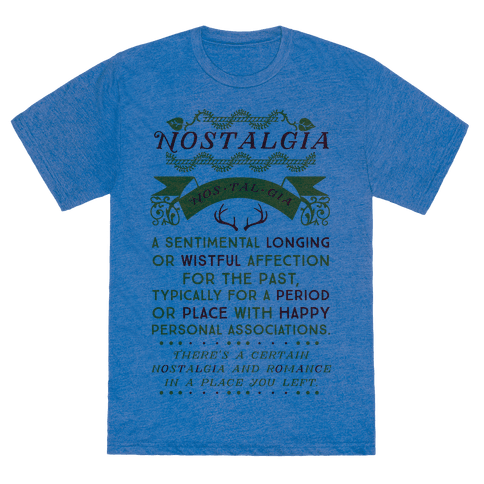
“We call an emotionally ambivalent motion, which means it has its complex right as positive features and negative features,” Routledge explains. While homesickness is pure ache, nostalgia is a unique mix of ache and pleasure.
#NOSTALGIA MEANING TV#
“There’s a tinge of sadness or loss because you know you can’t have that exact thing again.”īut watch someone find an old-school Gameboy or the opening credits of their favorite childhood TV show, and you’ll likely find them smiling. In describing the anxieties of soldiers fighting away from home, he combined the Greek word for homecoming, nostos, with the word for pain, algos. This is where nostalgia gets its name: the word was coined by a Swiss medical student, Johannes Hofer, in his 1688 dissertation. In the earliest days of nostalgia study, Routledge says, “it was seen as simply as homesickness.” Is nostalgia a positive or negative emotion? Our brains form particularly strong connections during this process in case recollection of the smell is important for survival. Smells from childhood are particularly powerful in this respect because very often our first exposure to scents is in childhood. The olfactory bulb is directly connected to the amygdala, an area of the brain responsible for processing emotion, and the hippocampus, an area of the brain associated with memory. All of those scents are sorted and parsed in the body’s olfactory bulb, which extends from your nose to the base of your brain. If you’re hiking in the Sierras, you’re smelling fresh air, dirt, and too many trees and plants to count.

Studies have shown that smells, like my trusty mountain misery, can be an especially powerful catalyst for nostalgic memories. “Most of the time when you’re nostalgic, it’s autobiographical you’re accessing what we call ‘self-relevant memories,” he explains. “Nostalgia is one of the self-regulatory tools we use to remind ourselves that we matter.” ShutterstockĪ very specific kind of memory is being activated during nostalgia, Routledge says.

The more those systems “worked cooperatively,” the researchers found, the more nostalgia people felt. When nostalgia was triggered, participants’ brains showed activity in two powerful neural networks: the areas of the brain associated with memory and the brain’s reward system. What nostalgia does to the brainĪ 2016 study used fMRI imaging to monitor participants’ brain activity when they were exposed to nostalgia-inducing stimuli. In other words, you’re unlikely to feel nostalgic about something that happened yesterday, but you likely have a nostalgic memory or two from a decade ago.

It’s called mountain misery, or Chamaebatia foliolosa. Under resplendent Douglas Firs, cedars, and Manzanita trees creeps a green shrub with a powerful odor.


 0 kommentar(er)
0 kommentar(er)
